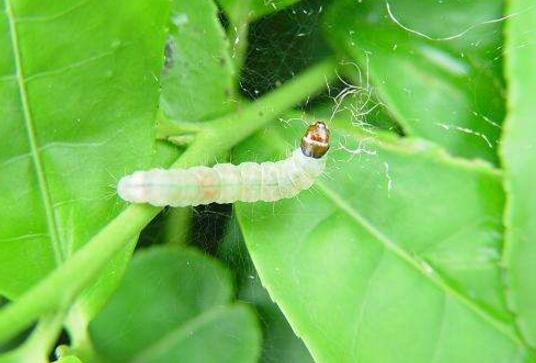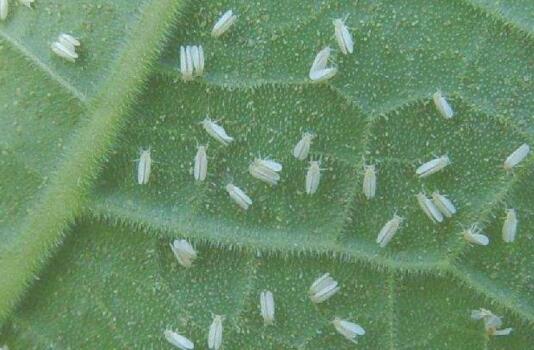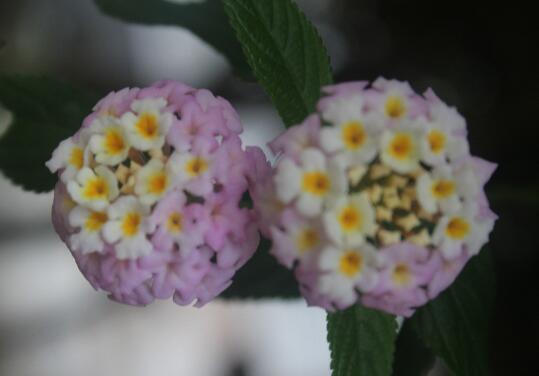What about the ivy worms? the prevention and control of ivy diseases and insect pests / finding the right cause is crucial.
Ivy is not a very delicate plant, its ability to adapt to the environment is relatively strong, but in the process of growth, if we do not understand the breeding methods of ivy, it will inevitably be plagued by diseases and insect pests. What if we raise ivy worms? It is very important to master certain prevention and control methods of ivy diseases and insect pests.
What about the ivy worms?
1. Chilo suppressalis

Symptoms: the larvae of the leaf borer hide in the leaves of the ivy and feed on the mesophyll, the veins and upper epidermis appear a transparent grayish-brown film, and the droppings of the leaf borer appear on the leaves, and then the leaves become withered and yellow.
Control methods: (1) trapping overwintering mature larvae with bunches or heaps of grass; (2) spraying 1000 times of dichlorvos EC or 1500 times of double-acting phosphorus EC before rolling leaves at the end of the second instar.
2. Red spider
Symptoms: the leaves of ivy are yellow and white, with red leaves, pear-shaped leaves and long black spots on both sides of the back, which usually occur in early June or July, if not timely control will threaten the growth of ivy. It is one of the most harmful pests in the prevention and control of ivy diseases and insect pests.
Control methods: (1) when it is found that the leaf color of ivy is abnormal, pay attention to observe and check the back of the leaf, and find that the red mite should remove the diseased leaf; (2) spray 2000 times of the wettable powder, or 2000 times of the EC.
3. Aphids
Symptoms: aphids will appear in the young leaves and stems at the top of ivy plants. if the leaf stem grows aphids, it will grow slowly, yellowing and even deformation. it is one of the most common pests in many plants.
Control method: when a small number of aphids are present in ⑴, the aphids can be brushed off with a brush and the crimped and withered leaves can be cut off; ⑵ is sprayed with 50% marathon emulsion diluted into a solution of 100 times.
Control of ivy diseases and insect pests
1. Anthrax
Symptoms: often occur in the autumn rainy season, the disease occurs when the leaves appear gray-white disease spots, cotyledons appear reddish brown near round disease spots on the young stem rust spots, and then expand into short stripe rust spots.
Control methods: ⑴ anthracnose emission concerns are excessive humidity and insufficient ventilation, so water should be stopped and ivy should be moved to a ventilated and transparent place; ⑵ sprays 50% carbendazim wettable powder 500x.
2. Sunburn
Symptoms: the upper leaves and new leaves of ivy turn light gray and slowly wither and fall early, usually because the shady ivy soil is moved to the sun, causing the ivy to be burned by the scorching sun.
Prevention and control methods: do not put ivy in a dark environment during cultivation, do not move it directly from the dark to the sun, usually plant in a bright place, and pay attention to the breeding methods of ivy.
3. Epidemic disease
Symptoms: most of the leaves of the ivy turn brown and rotten, the base of the stem appears dark green and watery, and the diseased branches begin to wither. The cause of the disease is generally caused by excessive humidity and muggy environment, which is caused by bacteria in the soil.
Control methods: ⑴ pull out diseased leaves or plants, reduce watering times and amount; ⑵ spray or irrigate 25% metalaxyl wettable powder 800x or 58% metalaxyl, manganese zinc wettable powder 600x solution; ⑶ plum rainy days should be timely drainage, pay attention to waterlogging prevention.
What if the ivy leaves turn yellow?
Causes of yellowing of ivy leaves
The influence of light
Ivy is a common green leafy plant in winter. It doesn't need shade in winter, and it doesn't matter if the light is properly strong. But the summer sun is strong, if it does not move, it is still normal to receive sunlight, which is easy to cause foliar necrosis.
The influence of temperature
Ivy likes a cool environment and is afraid of muggy heat and frost, especially the early frost in autumn and winter. if it is not moved indoors in time, the leaves will droop and turn yellow by frost. There is indoor breeding in summer, not timely ventilation, muggy environment, will also cause yellow leaves.
The influence of moisture
The biggest ornamental of ivy lies in the leaves, and the supply of water is the premise to ensure that the leaves are full. During the growth period, it is necessary to ensure that the basin soil is moist, but can not accumulate water. many flower friends do not grasp the degree well in the maintenance process, resulting in the basin soil suddenly dry and wet, the plant can not get enough water, and the plant metabolism is slow, resulting in plant yellow leaves.
Diseases and insect pests
Plant diseases and insect pests can not be avoided in the process of plant maintenance, but in some cases, people can not see bugs on the leaves, not timely control, it will cause yellow leaves of the plant. Or in the role of leaf spot disease, the plant will not have any signs of yellow leaves, difficult to prevent.
Lack of fertilizer
The leaves of ivy always turn yellow and may be hungry, people eat when they are hungry, and plants need nutrients when they are hungry. When the leaves of the plant turn yellow, it is obvious that there is a lack of iron, and it is in the process of maintenance that the elements are not fertilized for a long time, or the elements are not balanced during fertilization.
What if the ivy leaves turn yellow?
The temperature should be suitable.
Since Ivy is picky about temperature, satisfy it. After all, you also covet other people's beauty. Control the ambient temperature at 20-25 ℃, and always pay attention to the ambient humidity and often ventilate. The winter temperature should be controlled above 5 ℃, and the best temperature is about 10 ℃.
The illuminance should be moderate
Under suitable light, the leaves of ivy will be consistent in shape and bright in color. If the plant turns yellow due to light, the serious leaves will be cut off directly, and the newly grown young leaves will be retained and given appropriate light to make them recover slowly.
Watering should be moderate.
In the growing season to see dry and wet (that is, do not let the basin soil too wet, also can not be too dry), if too much water will have rotten roots and fallen leaves. Especially in winter, the temperature is on the low side, so it is especially necessary to control watering, as long as the basin soil is a little moist.
Fertilization should be reasonable.
When cultivating ivy at home, the basin soil can be made of rotten leaves or charcoal soil mixed with 4 river sand and a small amount of bone powder, and thin pancake fertilizer and water can be applied once in 2 to 3 weeks in the growing season. General summer and winter do not apply fertilizer, fertilization should also be careful not to choose to apply nitrogen fertilizer. When fertilizing, we should also be careful not to defile the leaves, so as not to cause the leaves to scorch. Yellow leaves caused by iron deficiency should be supplemented with iron in time and irrigated with ferrous sulfate solution.
The reason for the yellowing of ivy leaves, how to deal with it
Causes of yellowing of ivy leaves 1. Weak light leads to yellowing of leaves
Ivy is a common green leafy plant in winter. It doesn't need shade in winter, and it doesn't matter if the light is properly strong. But the summer sun is strong, if it does not move, it is still normal to receive sunlight, which is easy to cause foliar necrosis.
2. High temperature leads to yellowing of leaves.
Ivy likes a cool environment and is afraid of muggy heat and frost, especially the early frost in autumn and winter. if it is not moved indoors in time, the leaves will droop and turn yellow by frost. There is indoor breeding in summer, not timely ventilation, muggy environment, will also cause yellow leaves.
3. Deficiency leads to yellowing of leaves
The leaves of ivy always turn yellow and may be hungry, people eat when they are hungry, and plants need nutrients when they are hungry. When the leaves of the plant turn yellow, it is obvious that there is a lack of iron, and it is in the process of maintenance that the elements are not fertilized for a long time, or the elements are not balanced during fertilization.
4. Excessive drying of water leads to yellow leaves.
The biggest ornamental of ivy lies in the leaves, and the supply of water is the premise to ensure that the leaves are full. During the growth period, it is necessary to ensure that the basin soil is moist, but can not accumulate water. many flower friends do not grasp the degree well in the maintenance process, resulting in the basin soil suddenly dry and wet, the plant can not get enough water, and the plant metabolism is slow, resulting in plant yellow leaves.
5. Diseases and insect pests cause leaf yellowing
Plant diseases and insect pests can not be avoided in the process of plant maintenance, but in some cases, people can not see bugs on the leaves, not timely control, it will cause yellow leaves of the plant. Or in the role of leaf spot disease, the plant will not have any signs of yellow leaves, difficult to prevent.
What if the ivy leaves turn yellow? 1. Make the temperature suitable for you.
Since Ivy is picky about temperature, satisfy it. After all, you also covet other people's beauty. Control the ambient temperature at 20-25 ℃, and always pay attention to the ambient humidity and often ventilate. The winter temperature should be controlled above 5 ℃, and the best temperature is about 10 ℃.
2. Give enough light
Under suitable light, the leaves of ivy will be consistent in shape and bright in color. If the plant turns yellow due to light, the serious leaves will be cut off directly, and the newly grown young leaves will be retained and given appropriate light to make them recover slowly.
3. Watering should be moderate.
In the growing season to see dry and wet (that is, do not let the basin soil too wet, also can not be too dry), if too much water will have rotten roots and fallen leaves. Especially in winter, the temperature is on the low side, so it is especially necessary to control watering, as long as the basin soil is a little moist.
4. Fertilize and give adequate nutrition
When cultivating ivy at home, the basin soil can be made of rotten leaves or charcoal soil mixed with 4 river sand and a small amount of bone powder, and thin pancake fertilizer and water can be applied once in 2 to 3 weeks in the growing season. General summer and winter do not apply fertilizer, fertilization should also be careful not to choose to apply nitrogen fertilizer. When fertilizing, we should also be careful not to defile the leaves, so as not to cause the leaves to scorch. Yellow leaves caused by iron deficiency should be supplemented with iron in time and irrigated with ferrous sulfate solution.
- Prev

What about the one-leaf orchid worm, the disease and pest control of one-leaf orchid / five tricks to avoid the early fall of leaf yellow
Although the one-leaf orchid has a strong resistance to diseases and insect pests and its own adaptability is also very strong, if you do not understand the correct culture method of one-leaf orchid, it may still be disturbed by many diseases and insect pests. Let's take a look at the prevention and control methods of diseases and insect pests of Cymbidium.
- Next

How to deal with the long insects of the orchids, the pest control of orchids/2 pests 2 diseases
In the process of breeding ball orchids, the last thing people want to encounter is definitely diseases and insect pests. This kind of problem not only affects the beauty of the plant, but also poses a great threat to the plant. What about the long insects in the ball orchids? How to prevent and control diseases and insect pests in orchids
Related
- Fuxing push coffee new agricultural production and marketing class: lack of small-scale processing plants
- Jujube rice field leisure farm deep ploughing Yilan for five years to create a space for organic food and play
- Nongyu Farm-A trial of organic papaya for brave women with advanced technology
- Four points for attention in the prevention and control of diseases and insect pests of edible fungi
- How to add nutrient solution to Edible Fungi
- Is there any good way to control edible fungus mites?
- Open Inoculation Technology of Edible Fungi
- Is there any clever way to use fertilizer for edible fungus in winter?
- What agents are used to kill the pathogens of edible fungi in the mushroom shed?
- Rapid drying of Edible Fungi

